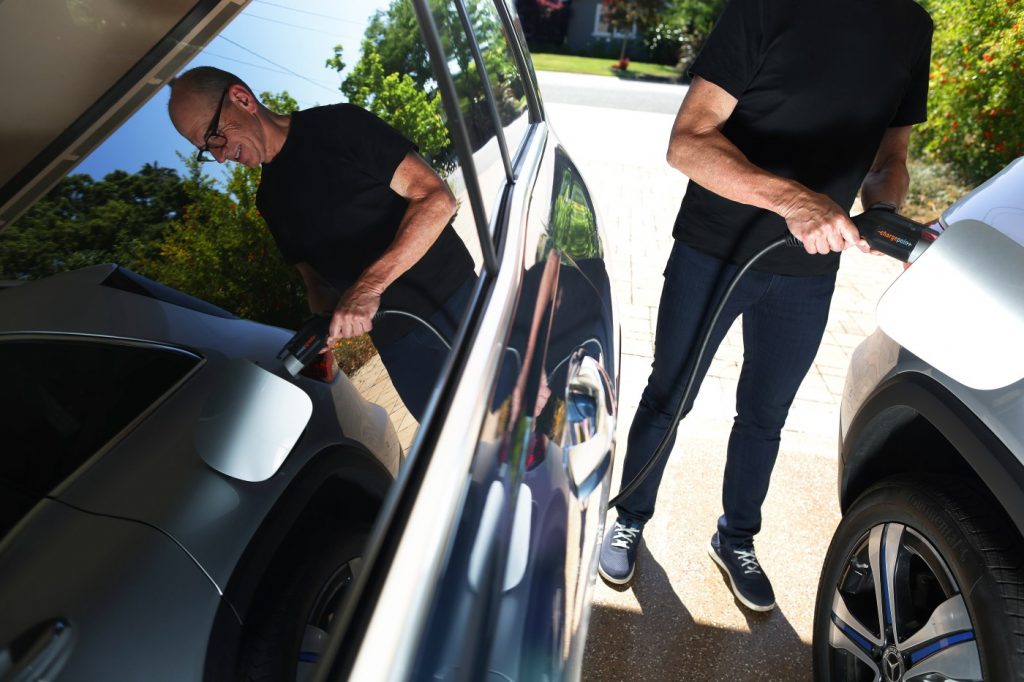Sales of zero-emission electric cars continue to tick up in California, driving the Golden State on a vastly different trajectory than the rest of the country.
Nearly 24% of all new cars sold here during the first three months of the year were zero-emission electric vehicles, known as ZEVs, according to new data from the California Energy Commission.
By comparison, just 7.5% of cars sold nationwide were ZEVs, according to the California New Car Dealers Association, which represents auto dealers.
“The EV transition is in full swing, with nearly one in four California car shoppers choosing to go electric over the last year, resulting in record sales,” David Hochschild, chair of the California Energy Commission, said in a statement. “This is good news for all Californians, as our success delivers cleaner air statewide and drives significant investment in our emerging zero-emission vehicle industry.”
EVs or ZEV’s are battery electric vehicles that emit zero emissions from their power source.
In the first quarter of 2024, Californians purchased 102,507 ZEVs. That’s the highest number for a first quarter of any year, according to the California Energy Commission. Total sales also increased from the previous quarter.
For John W. Crittenden, a retired attorney from Los Altos, comfort was a driving force in his decision to purchase an EV, but reducing his carbon footprint also played a part when he went looking to buy a new vehicle.
“We wanted something that had comfortable seats with good thigh and lumbar support, and that is hard to come by unless you go with a more expensive car,’’ said Crittenden, 67. After test driving EVs made by Mercedes Benz, VW, Jaguar and Audi, Crittenden purchased a blue Mercedes EQB 300 in May of last year. He liked it so much that four months later, he and his wife leased a second one.
“We love our EVs — they’re quiet, fun to drive and cost little or nothing with electricity from our solar panels to fuel,” he said. “We will never go back to gasoline-powered cars.”
While comfort and style were important, the couple also considered the environmental impact of purchasing another gas-powered car. “It’s so important,’’ he said. “You are thinking, ‘I’ve contributed so much damage to the environment, and I want to make amends at this point.’ ”
In the last week, California surpassed both its zero-emission truck sales and vehicle sales goals — two years ahead of schedule — and surpassed its goal of installing 10,000 fast EV chargers, more than a year ahead of schedule.
With 60 ZEV manufacturers based in California, according to Gov. Gavin Newsom’s office, including Lucid Motors in Newark, the success of the state’s programs has led to ZEVs becoming a top export and has spurred major advances in manufacturing and job creation.
Although a record 1.2 million U.S. vehicle buyers went electric last year, according to estimates from Kelley Blue Book, new national survey data from AAA shows that interest in buying a ZEV is waning.
Just 18% of people polled across the nation said they would be “likely” or “very likely” to buy a used or new EV, a drop from the 23% the same survey found a year earlier.
“Early adopters who wanted an EV already have one,” Greg Brannon, AAA’s director of automotive research, said in a statement.
The survey, conducted in April, included more than 1,100 interviews with American adults. AAA said the survey provides sample coverage of approximately 95% of the U.S. household population.
The survey said Americans are passing up EVs for several reasons, including higher purchase prices. Sixty percent of those surveyed said price was the largest single reason for preferring gas-powered vehicles. Infrastructure was another reason, with 54% of respondents saying that a lack of convenient places to charge kept them from buying an EV. Maintenance costs were also a factor with more than 57% of those polled saying the cost of battery repair or replacement was a sticking point.
But in the Golden State, it’s a different story, and it starts with the weather.
“EVs do really well in moderate temperatures,’’ said Kelley Blue Book auto-industry analyst Brian Moody. “When it’s very cold, well below freezing, the cars take longer to charge, and they don’t hold a charge as much.”
California is also making it easier to charge electric vehicles.
The California Energy Commission in April approved $1.9 billion to build 40,000 new public EV chargers statewide and other ZEV infrastructure across California.
The investments are part of Newsom’s $10 billion budget for ZEVs, which is bolstered by billions of dollars for clean transportation from the Biden-Harris Administration.
Related Articles
Opinion: How California can rewrite extraction business model and boost Salton Sea communities
Thefts of charging cables pose another obstacle to appeal of electric vehicles
A heat wave will cook your electric car battery, if you let it
Many Americans are still shying away from EVs despite Biden’s push: poll
Elon Musk accused of improperly selling $7.5 billion in Tesla stock before weak sales report that crashed its price
Another reason EV sales in California are outpacing sales in other parts of the country is people are keenly aware how the climate crisis uniquely impacts California.
In recent decades, California has continued to face significant pollution and climate challenges. In fact, the state includes seven of the 10 worst areas for ozone pollution in the country and six of the 10 worst areas for small particulate matter, according to Newsom’s office.
The state also faces increasing risks from record-setting fires, heat waves, storm surges, sea-level rise, water supply shortages and extreme heat. And these conditions are made worse by climate change.
However, California has emission rules set to slow climate change and reduce pollution. Starting in 2035, the state’s rules will require that all new cars sold in California be EVs. What’s more, the Clean Air Act allows the state to set motor vehicle emissions standards that are at least as or more stringent than national standards pursuant to a waiver from the Environmental Protection Agency, according to the nonprofit Environmental Defense Fund.
Last year, California was challenged on those rules by oil and gas companies and 17 Republican-led states that wanted to deny the state’s authority to set clear car standards as guaranteed by federal law.
In April, the U.S. Court of Appeals for the District of Columbia Circuit rejected the challenge to the constitutionality of the Clean Air Act provision allowing California to continue to set its own clean cars standards, which, given the size of the Golden State’s economy, can pave the way for other states to follow suit.
“The clean vehicle transition is already here — it’s where the industry is going, the major automakers support our standards, and California is hitting our goals years ahead of schedule,’’ Newsom said in a statement. “We won’t stop fighting to protect our communities from pollution and the climate crisis.”


